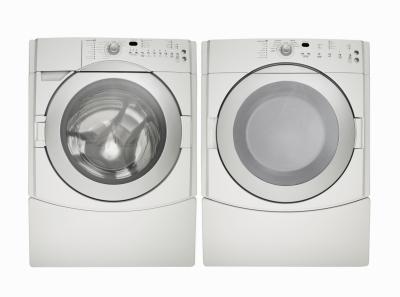
Thermal overload occurs when an electric motor overheats to the point of temporary cutoff or total failure. Motors that can experience thermal overload include washing machines, dryers, large fans, air conditioning units, pool and spa water pump motors and other appliances which have internal electrical winding. Thermal overload can be tested by a DIY repair person, once some obvious symptoms are recognized. Finding faulty electric motor components quickly can reduce and eliminate future thermal overload problems, which could forestall complete motor failure.
Sniff the air to sense any type of burnt or acrid smell near your unit or appliance, which houses the motor. The burnt odor will be more prevalent during motor operation or just after shutdown. A burning odor is the first indication of a high-temperature thermal overload on any unit that has an electrical motor. Shut the unit off immediately if you smell foul burning odors from your appliance during operation.
Turn off your main breaker to your appliance or unit, then unplug it from the wall outlet, if you suspect an overheating problem or hear a loud humming or grating noise. Allow the appliance or unit to cool off. This also applies if it has suddenly shut off by itself, or tripped a circuit breaker on the main panel. If your appliance or unit has a cover panel, as with a dryer or washing machine, use either a socket or screwdriver to remove the panel.
Inspect the panel cooling vents for any clogs of dust, dirt, hair, lint or other obstructions. Use a brush to clean away all debris from the vents — if cool air can not circulate around the motor winding it will overheat. Check the main power supply wire that leads to the motor case. If it has a nut and bolt connector, look for burn marks on the contact and on the wire insulation. Wire insulation on the main power supply line that has a blackened, burnt or crinkled appearance indicates excessive current.
Look for a red button on the side of the motor, which is an overload reset button. It might be marked with the word "Reset," so check your service manual for its exact location. To test the reset button's operation, turn the circuit breaker back on and plug in the appliance. Very carefully, push the reset button. If the appliance turns on now, whereas it did not before, you know you have an overload condition. Turn off the circuit breaker and unplug the appliance.
Clean away any debris from the motor case with a brush, if it has vents in the back of the motor cover plate. If the motor drives a belt, use a socket to loosen the motor mount bracket bolts, just enough to slip the belt off.
Turn the motor driveshaft by hand. If you feel grating or heavy resistance, it indicates worn or binding driveshaft bearings, which causes strain on the stator and armature winding. Some electrical motors have a small oil cap, which allows you to insert a few drops of oil into the bearing case. This can let the motor function without friction and solve an overheating problem.
Remove the back cover plate of the motor with a socket and wrench. Unplug any wire connector that feeds through the back plate, or feed the wire through the case grommet, if it has this configuration. The motor might have a small inspection plate, which you can remove with a screwdriver.
Inspect the stator, which is the large electrical ring, and the armature, which is the large copper shaft, for any signs of burnt wiring and insulation, which will appear dark yellow, brown or black. This indicates excessive current voltage. Replace the motor if you see these symptoms.
Examine the armature (or commentator) and brushes for unusual wear. The armature should have a smooth, copper color to it, with no pits or discoloration. The small electrical contact brushes should be nearly flush and riding smoothly on the armature surface. If the brushes look worn down to their bracket holders, they must be replaced.